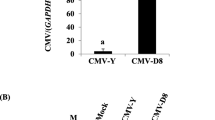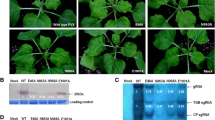Abstract
Cross protection is a promising alternate to control Cucumber green mottle mosaic virus (CGMMV) which is of increasing economic importance to cucurbit production worldwide. One major factor confronting the application of cross protection to control CGMMV is the scarcity of available mild mutants. The objective of this paper was to screen attenuated mutants of CGMMV and evaluate their potential in cross protection. An infectious cDNA clone of CGMMV, pCGMMV, was obtained by cloning intron-containing CGMMV genome to modified pCambia0390 vector with the Cauliflower mosaic virus 35S promoter. Five pCGMMV-derived mutants were obtained via site-directed mutagenesis and inoculated to Nicotiana benthamiana plants for symptom observation. The attenuated CGMMV mutants were evaluated for their efficiency in cross protection. The intron-containing clone pCGMMV induced similar disease symptoms and accumulated similar titres of virus in N. benthamiana plants as wild-type CGMMV. Mutations of aspartic acid at position 89 in the coat protein to alanine (D89A) or glutamic acid at position 1069 in the ORF1/2 read-through protein, in the RNA-dependent RNA polymerase domain to alanine (E1069A) alleviated the symptoms of pCGMMV in N. benthamiana plants significantly. In cross protection assay, the two mutants pCGMMV-CP-D89A and pCGMMV-RdRp-E1069A could prevent the superinfection of CGMMV, with protection efficiency of 91.7% and 100%, respectively. The intron-containing clone pCGMMV was stable and highly infectious. The D89 in the coat protein and E1069 in the RNA-dependent RNA polymerase played an important role in regulating the virulence of CGMMV. Mutants pCGMMV-CP-D89A and pCGMMV-RdRp-E1069A were of great potential in the control of CGMMV via cross protection.



Similar content being viewed by others
Abbreviations
- bp:
-
Base pairs
- CGMMV:
-
Cucumber green mottle mosaic virus
- CP:
-
Coat protein
- MP:
-
Movement protein
- ORF:
-
Opening reading frames
- PMMoV:
-
Pepper mild mottle mosaic virus
- PTA-ELISA:
-
Plate-trapped antigen enzyme-linked immunosorbent assay
- qRT-PCR:
-
Quantitative real-time polymerase chain reaction
- RdRP:
-
RNA-dependent RNA polymerase
- ToMV:
-
Tomato mosaic virus
- UTR:
-
Untranslated region
References
McKinney H (1929) Mosaic diseases in the Canary Islands, West Africa, and Gibraltar. J Agric Res 39:577–578
Owor B, Legg JP, Okao-Okuja G, Obonyo R, Kyamanywa S, Ogenga-Latigo MW (2004) Field studies of cross protection with cassava mosaic geminiviruses in Uganda. J Phytopathol 152:243–249
Burgyan J, Gaborjanyi R (1984) Cross-protection and multiplication of mild and severe strains of TMV in tomato plants. J Phytopathol 110:156–167
Gal-On A, Shiboleth YM (2006) Cross-protection. Natural resistance mechanisms of plants to viruses. Springer, Dordrecht, pp 261–288
Istomina EA, Snegireva PB, Shiian AN (2004) Construction of a full-length cDNA of tobacco mosaic virus strain V-69 genome. Russ J Genet 40:1356–1363
Kosaka Y, Ryang BS, Kobori T, Shiomi H, Yasuhara H, Kataoka M (2006) Effectiveness of an attenuated Zucchini yellow mosaic virus isolate for cross-protecting cucumber. Plant Dis 90:67–72
Nishiguchi M, Kobayashi K (2011) Attenuated plant viruses: preventing virus diseases and understanding the molecular mechanism. J Gen Plant Pathol 77:221–229
You BJ, Chiang CH, Chen LF, Su WC, Yeh SD (2005) Engineered mild strains of Papaya ring spot virus for broader cross protection in cucurbits. Phytopathology 95:533–540
Francki RI, Hu J, Palukaitis P (1986) Taxonomy of cucurbit-infecting tobamoviruses as determined by serological and molecular hybridization analyses. Intervirology 26:156–163
Ugaki M, Tomiyama M, Kakutani T, Hidaka S, Kiguchi T, Nagata R, Nagata R, Sato T, Motoyoshi F, Nishiguchi M (1991) The complete nucleotide sequence of cucumber green mottle mosaic virus (SH strain) genomic RNA. J Gen Virol 72:1487–1495
Wang H, Stubbs G (1994) Structure determination of Cucumber green mottle mosaic virus by X-ray fiber diffraction: significance for the evolution of tobamoviruses. J Mol Biol 239:371–384
Choi GS (2001) Occurrence of two tobamovirus diseases in cucurbits and control measures in Korea. Plant Pathol J 17:243–248
Kim SM, Lee JM, Yim KO, Oh MH, Park JW, Kim KH (2003) Nucleotide sequences of two Korean isolates of Cucumber green mottle mosaic virus. Mol Cells 16:3
Lee KW, Lee BC, Park HC, Lee YS (1990) Occurrence of cucumber green mottle mosaic virus disease of watermelon in Korea. Korean J Plant Pathol 6:250–255
Slavokhotova AA, Istomina EA, Andreeva EN, Korostyleva TV, Pukhalskij VA, Shijan AN, Odintsova TI (2016) An attenuated strain of cucumber green mottle mosaic virus as a biological control agent against pathogenic viral strains. Am J Plant Sci 7:724
Yoon J, Choi G, Choi S, Hong J, Choi J, Kim W, Lee GP, Ryu KH (2008) Molecular and biological diversities of Cucumber green mottle mosaic virus from cucurbitaceous crops in Korea. J Phytopathol 156:408–412
Xu S, Liu Q, Geng C, Wang Y, Tian YP, Jia X (2016) Complete genomic sequences-based recombination and phylogenetic analysis of Cucumber green mottle mosaic virus. Acta Phytopathol Sin 46:320–327
Tan S-H, Nishiguchi M, Sakamoto W, Ogura Y, Murata M, Ugaki M, Motoyoshi F (1997) Molecular analysis of the genome of an attenuated strain of cucumber green mottle mosaic virus. Jpn J Phytopathol 63:470–474
Liu J, Li Y, Huang X, Fang L, Li X, Tian Y (2017) Preparation of antiserum to Cucumber green mottle mosaic virus with coat protein expressed in E. coli. Shandong Agric Sci 49:10–13
Caldo RA, Nettleton D, Wise RP (2004) Interaction-dependent gene expression in Mla-specified response to barley powdery mildew. Plant Cell 16:2514–2528
Towbin H, Staehelin T, Gordon J (1979) Electrophoretic transfer of proteins from polyacrylamide gels to nitrocellulose sheets: procedure and some application. Proc Natl Acad Sci 76:4350–4354
Ooi AS, Tan SH, Mohamed R, Rahman NA, Othman RY (2006) The full-length clone of cucumber green mottle mosaic virus and its application as an expression system for Hepatitis B surface antigen. J Biotechnol 121:471–481
Park CH, Ju HK, Han JY, Park JS, Kim IH, Seo EY, Kim JK, Hammond J, Lim HS (2017) Complete nucleotide sequences and construction of full-length infectious cDNA clones of cucumber green mottle mosaic virus (CGMMV) in a versatile newly developed binary vector including both 35S and T7 promoters. Virus Genes 53:286–299
Zheng HY, Xiao CL, Han KL, Peng JJ, Lin L, Lu YW, Xie L, Wu XH, Xu P, Li GJ, Chen JP, Yan F (2015) Development of an agroinoculation system for full-length and GFP-tagged cDNA clones of cucumber green mottle mosaicvirus. Arch Virol 160:2867–2872
Jakab G, Droz E, Brigneti G, Baulcombe D, Malnoe P (1997) Infectious in vivo and in vitro transcripts from a full-length cDNA clone of PVY-N605, a Swiss necrotic isolate of potato virus Y. J Gen Virol 78:3141–3145
Nagyová A, Subr Z (2007) Infectious full-length clones of plant viruses and their use for construction of viral vectors. Acta Virol 51:223
Yamshchikov V, Mishin V, Cominelli F (2001) A new strategy in design of (+) RNA virus infectious clones enabling their stable propagation in E. coli. Virology 281:272–280
Johansen IE, Lund OS (2008) Insertion of introns: a strategy to facilitate assembly of infectious full length clones. Plant Virol Protoc 451:535–544
Olsen B, Johansen I (2001) Nucleotide sequence and infectious cDNA clone of the L1 isolate of pea seed-borne mosaic potyvirus. Arch Virol 146:15–25
Satyanarayana T, Gowda S, Ayllon MA, Dawson WO (2003) Frameshift mutations in infectious cDNA clones of Citrus tristeza virus: a strategy to minimize the toxicity of viral sequences to Escherichia coli. Virology 313:481–491
Gao R, Tian YP, Wang J, Yin X, Li XD, Valkonen JP (2012) Construction of an infectious cDNA clone and gene expression vector of Tobacco vein banding mosaic virus (genus Potyvirus). Virus Res 169:276–281
López-Moya JJ, García JA (2000) Construction of a stable and highly infectious intron-containing cDNA clone of plum pox potyvirus and its use to infect plants by particle bombardment. Virus Res 68:99–107
Yang G, Qiu BS, Liu XG, Li Y, Wang XF (2002) Nonsense mutations of replicase and movement protein genes contribute to the attenuation of an avirulent tomato mosaic virus. Virus Res 87:119–128
Nishiguchi M, Kikuchi S, Kiho Y, Ohno T, Meshi T, Okada Y (1985) Molecular-basis of plant viral virulence—the complete nucleotide-sequence of an attenuated strain of Tobacco mosaic virus. Nucleic Acids Res 13:5585–5590
Ichiki TU, Nagaoka EN, Hagiwara K, Uchikawa K, Tsuda S, Omura T (2005) Integration of mutations responsible for the attenuated phenotype of Pepper mild mottle virus strains results in a symptomless cross-protecting strain. Arch Virol 150:2009–2020
Ali ME, Waliullah S, Nishiguchi M (2016) Molecular analysis of an attenuated strain of Cucumber green mottle mosaic virus using in vitro infectious cDNA clone: pathogenicity and suppression of RNA silencing. J Plant Biochem Biotechnol 25:79–86
Lin SS, Wu HW, Jan FJ, Hou RF, Yeh SD (2007) Modifications of the helper component-protease of Zucchini yellow mosaic virus for generation of attenuated mutants for cross protection against severe infection. Phytopathology 97:287–296
Acknowledgements
This study was supported by National Natural Science Foundation of China (NSFC, 31720103912; 31571984) and Funds of Shandong ‘Double Top’ Program (SYL2017XTTD11). We thank Xue-ying Wang from Jiyang Protection Station of Shandong Province for providing the CGMMV isolate.
Author information
Authors and Affiliations
Contributions
JL and SX designed and performed the experiments, analyzed the data, and wrote the manuscript. X-DL conceived the study and participated in design and coordination and writing. Reagents/materials/analysis tools were contributed by JL, SX, and X-DL. All authors read and approved the final manuscript.
Corresponding author
Ethics declarations
Conflict of interest
The authors declare that they have no conflict of interest.
Additional information
Edited by Karel Petrzik.
Publisher's Note
Springer Nature remains neutral with regard to jurisdictional claims in published maps and institutional affiliations.
Rights and permissions
About this article
Cite this article
Liu, J., Li, XD. & Xu, S. Single amino acid substitutions in the coat protein and RNA-dependent RNA polymerase alleviated the virulence of Cucumber green mottle mosaic virus and conferred cross protection against severe infection. Virus Genes 56, 228–235 (2020). https://doi.org/10.1007/s11262-019-01726-3
Received:
Accepted:
Published:
Issue Date:
DOI: https://doi.org/10.1007/s11262-019-01726-3




